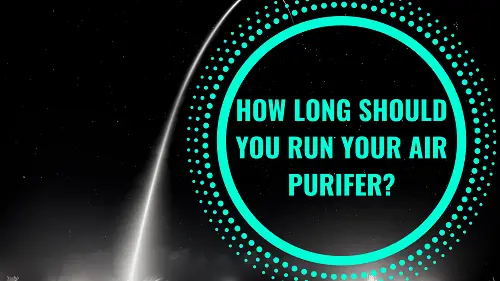To be absolutely sure you have clean air 24/7, it is safest to run your air purifier non-stop. However, you do not always need the air to be super clean, especially when you are not at home. Additionally, an air purifier uses electricity to run and its filters need to be cleaned and replaced. Therefore, reducing the time you need to run your air purifier has its benefits.
For an average room size of 300 square feet (28 m2), the correct CADR (Clean Air Delivery Rate) of 195 and an average ACH (Air Changes per Hour) of 4, 15 minutes is sufficient to clean all the air in the room. It is best to run the purifier longer than strictly necessary, especially when you have allergies or pets. To maintain clean air, an air purifier needs to run constantly.
Factors influencing required run time
There are several factors that influence the time you need to run your air purifier.
The following factors influence how long it needs to run:
- The size of the room (cubic feet)
- How heavily your air is polluted
- The condition of the filters in the air purifier
- The air changes per hour (ACH) of your device
- The clean air delivery rate (CADR) of your device
Some air purifiers have additional features that can help determine the required run time. These are, for example, an eco mode or small lights that shows the state of your indoor air quality.

Air Changes per Hour (ACH) is its speed
The Air Changes per Hour (ACH) of your air purifier is an important factor in determining how long the device should run. The ACH is basically the speed of the device. It shows how much time the purifier needs to run all the air in the room through its filters.
In other words, an ACH of 1 means that it takes the device 1 hour to clean all the air in your room. An ACH of 4 means it takes only 15 minutes since it cleans the room 4 times in one hour.
The ACH is based on the maximum recommended room size for your specific device. So if you have a larger room than mentioned on the packaging and manual, you will need to run it longer. If the room is smaller, you can lower the run time.
This of course only works if the device is used properly. So make sure you clean and replace the filters often. Additionally, the efficiency of the filters determines if one full run of your purifier is sufficient to properly clean the air.
Room size influences run time
In order to have clean air, all the air in the room needs to run through the filters of the air purifier. Therefore, next to the ACH, the size of the room is an important factor.
Usually, the manual or packaging of the air purifier mentions the maximum recommended room size. When you have a good enough purifier for your room (based on CADR, see below), the ACH is an excellent indication of the required run-time.
Since your filters get dirty over time resulting in lower efficiency, it is safest to run the device a bit longer.
What is the Clean Air Delivery Rate (CADR)
An air purifier can only clean so much air at a time. Therefore, the size of the room determines the required caliber of an air purifier. The caliber of an air purifier is the Clean Air Delivery Rate (CADR). This is the amount of air in cubic feet per minute that is cleaned by the air purifier. However, the CADR only applies to the removal of particles, not to the removal of gases.
The minimum required CADR is dependent on the room area. The table below shows the CADR needed for several room sizes in square feet (1 square foot is about 0.1 square meters).
Table 2. Estimated minimal CADR requirements (source: EPA)
| Room area in square feet | 100 | 200 | 300 | 400 | 500 | 600 |
| minimum required CADR | 65 | 130 | 195 | 260 | 325 | 390 |
Keep in mind that this table’s calculations are based on a height of 8 feet (2.5 meters). If you have a higher ceiling, you will need an air purifier with a larger CADR.
Something to keep in mind is that the CADR rating is based on a test run of 20 minutes. However, when an air purifier runs for some time, the filter will get full and the CADR will decrease. Therefore, make sure that you use an air purifier that has a higher CADR than necessary for the size of your room.
Multiple CADR numbers per air purifier
Normally, there should be three CADR numbers listed on an air purifier. These are for the different contaminants: smoke, pollen, and dust. Smoke has the largest particle size (and is therefore visible), pollen is smaller, and dust has the smallest particles.
Smaller particles are more dangerous since they can penetrate the lungs more easily.
Calculating the required run-time
The run-time of your air purifier can be calculated by using either the CADR or the ACH.
Run-time calculation with CADR
If you do not have the ACH of your air purifier, but you know its CADR(s), you can use them to calculate the required run-time.
You can calculate the required run-time by dividing the size of your room in cubic feet by the cadr of your air purifier. this will get you the minimal amount of minutes that the purifier needs to run.
Usually, the CADR for smoke is the lowest, and therefore the most conservative to use in our calculation.
Let’s use an example. You have:
| Smoke CADR (cfm) | 100 |
| Room size in cubic feet | 2400 (68m3) |
So, if we divide the room size by the CADR, we get:
2400 cubic feet / 100 cubic feet per minute = 24 minutes
Calculating run-time with ACH
If you do not know the CADR rating, you can calculate the run-time via the ACH. This is as simple as dividing 60 by the ACH. 60 / ACH.
So, if you have an ACH of 4, your required run-time is:
60 / 4 = 15 minutes run-time.
What if my room is bigger or smaller than the room size of the air purifier?
To calculate the required run-time when the size of your room differs from the room size mentioned on the air purifier (maximum recommended room size), you can do the following.
First, check if the height of your room is 8 feet because this is the default with which the air purifier has determined its recommended room size. If yours is significantly different, you can find the calculation in the next paragraph called: What if the height of my room differs?
Start with dividing the size of your room by the maximum recommended room size. Then multiply this with the time that it takes for one full air change. This will give you the required run-time.
For example, you have an air purifier with the following specifications:
| Maximum room size | 300 sq. ft (28 m2) |
| ACH | 4 |
| The actual size of your room | 400 sq. ft (37 m2) |
Divide the size of your room by the maximum room size:
400 sq. ft/300 sq. ft = 1.33
Then calculate the time needed to run all the air in your room through the device. This is done by taking 60 minutes and dividing this by the ACH. In this case:
60minutes/4 = 15 minutes
Then, multiply them:
15 minutes x 1.33 = 20 minutes run-time
What if the height of my room differs?
The standard height of a room is about 8 feet high. So, this is what the maximum recommended room size of your air purifier is based on. However, if the height of your room is different, you need to take this into account in your calculation of the run-time.
This is done in the following way: take the recommended room size of the air purifier and multiply this by 8. This will give you the recommended room size in cubic feet. Let’s take our example again:
| Maximum recommended room size | 300 sq. ft (28 m2) |
| ACH | 4 |
| The actual size of your room | 400 sq. ft (37 m2) |
Multiply the maximum room size by 8:
300 x 8 = 2400 cubic feet
Then take your room size in cubic feet: your square feet times the height of your room. let’s say it is 10 feet high and 400 square feet:
400 x 10 = 4000 cubic feet
Then, divide your room size in cubic feet by the calculated recommended room size in cubic feet:
4000 / 2400 = 1.67
Then, take the number of minutes based on our ACH of 4:
60 / 4 = 15 minutes
Then multiply the minutes by the room difference that we just calculated:
15 x 1.67 = 25 minutes run-time
Pollution levels determine run-time
In addition to the power of the air purifier, the amount of pollution in your room determines the run time of your purifier. Unfortunately, most air purifiers don’t indicate the pollution levels in your room. This means it is hard to know how your air quality is doing.
Some more advanced air purifiers, however, do indicate your air quality level with colored light. This is a very helpful tool as you can turn the device off or set in on its lowest setting when the indicator shows low levels of pollution.
Additionally, these lights can help to determine if you already want to enter the room or wait until the air is cleaner.

The condition of the filters influences run-time
Clogged filters reduce the effectiveness of your air purifier. Therefore, you should clean the device regularly, including the inside, and check if the filters need replacement.
When to clean and replace filters
I have looked into several air purifier manuals and found the following cleaning and replacement recommendations.
| Filter | method | Cycle |
|---|---|---|
| Pre-filter | cleaning/vacuuming | every 2 to 4 weeks |
| Deodorization filter | replacing | every 6 months |
| HEPA filter | replacing | once every year |
| Non-HEPA main filter | replacing | every 6 months |
Eco mode
Some air purifiers, like the Coway mighty, have an eco mode. This mode is designed to save energy by turning off when purification is not needed. The Coway mighty in eco mode stops when no pollutants were detected for the past 30 minutes. It will turn on again when it senses new air pollutants.
I would recommend checking if your air purifier has an eco mode or something similar and what it does exactly. On top of that, I suggest that you base the run-time on the options that this mode gives you.
In the case of the Coway mighty, I suggest running it on auto mode (this mode regulates the fan speed based on the amount of dust detected) until it runs at its lowest mode for a while. This will indicate that your air quality is quite clean, and you can safely turn it on eco mode.
Other factors that influence the run time
Even if you have the perfect air purifier for your room, there can still be other factors holding back the effectiveness of your air purifier. And if your air purifier is less effective, the required run-time becomes higher.
Things to consider are:
- pets shed hair and dander, resulting in dust particles that clog your filters more quickly
- if you have allergies, you might require extra clean air. Therefore, you should consider running the purifier for a longer time or purchasing a higher-quality purifier.

